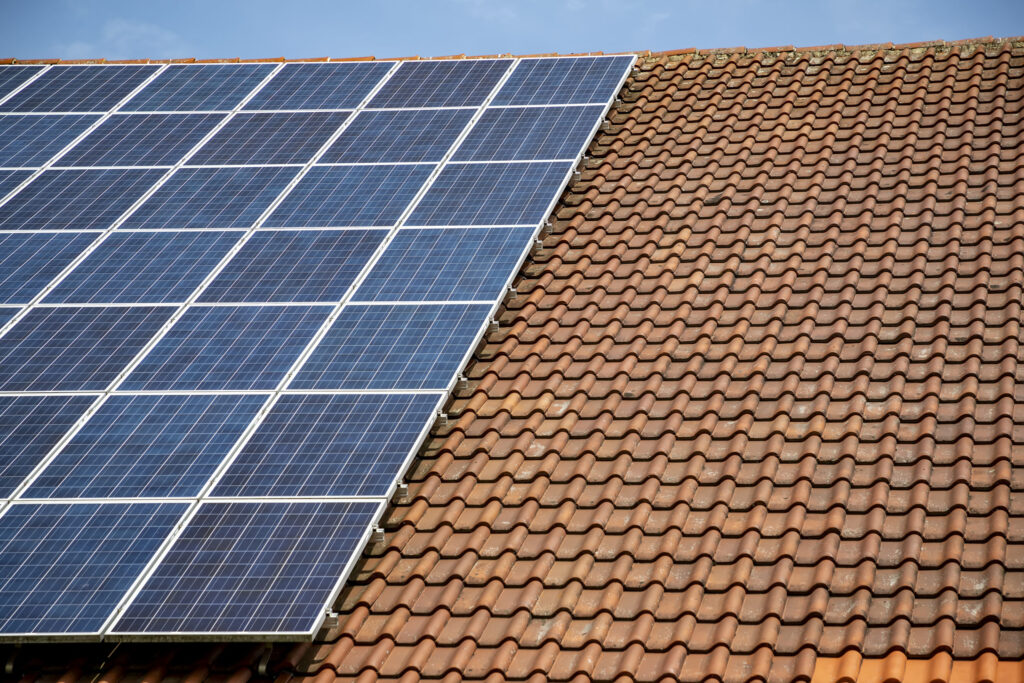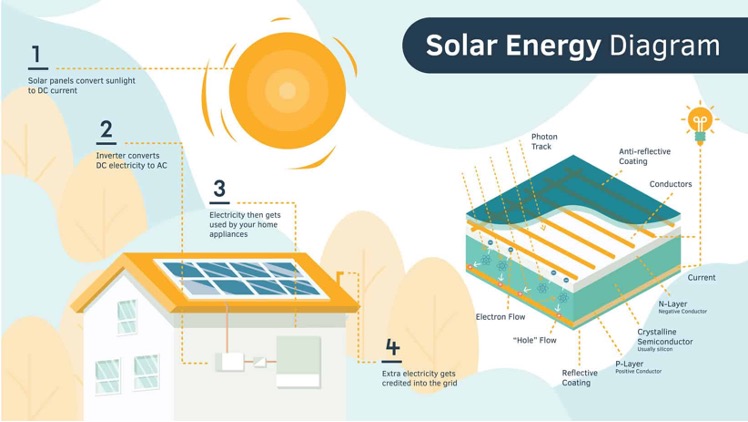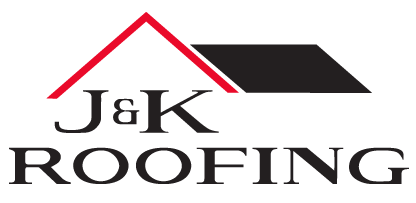
The Science of Solar: How Do Solar Panels Work and Are They Right For My Home?
Solar panels have increased significantly in popularity over the last five years, with an estimated two million American homes going solar as of 2019. They are an Earth-friendly option that can even earn income in the long term for the homeowner. But how, exactly, do these panels work?
The Science of Solar Panels
It may seem like magic: the sun shines on them and is transformed into electricity to power the building. But it is actually a fairly simple process that utilizes decades-old scientific knowledge about light and electric currents. In a few steps, sunlight is converted at the atomic level into an electrical current. Technology does the rest.

Basic steps in the conversion of sunlight to electricity. The general construction of a solar panel is on the right. Image courtesy of thesolaradvantage.net
Step One: Convert Light Energy to Electric Energy
Solar panels are made up of rows of photovoltaic cells. (The word “photovoltaic” simply means converting light into energy.) The cells themselves are made of silicon, a semiconductor. A semiconductor is useful because it is a material that can be “doped” to create an electric field, which is necessary to allow electricity to flow. When light photons hit the silicon cells, electrons are freed and directed in a circuit to form a current of electricity.
Step Two: Create an Electric Field
In order to maintain a flow of electric energy, an electric field is necessary. This is similar to a magnetic field, which relies on a negative pole and a positive pole. As mentioned above, silicon can be doped or treated, create a negative charge on one side and a positive charge on the other. In this case, phosphorus is used to create a negative charge, and boron is used to create a positive charge.
When an electron is knocked loose from the silicon semiconductor, it is then free to travel along the electric field, being attracted to the opposite charge in a direct current (DC) of electricity.

Illustration of the electric field. Particles move from positive charge to negative charge. Image courtesy of toppr.com
Step Three: Convert From DC to AC
At the end of each solar panel is a conductive wire. This wire brings the DC electricity to an inverter, where it is converted to Alternating Current (AC) electricity. This is the form of electricity that is most commonly used to power buildings and devices.
The reason for this has to do with the fact that, unlike DC electricity, AC voltage can be adjusted from high to low. It is also capable of traveling much farther distances. As the name suggests, this form of electricity periodically reverses direction in the energy circuit.
By contrast, electrons in DC electricity always flow in the same direction. DC electricity is found in another type of voltaic cell, also known as the alkaline battery.
There you have it! The process of converting sunlight into an alternating current of usable electricity for your home.
Is Solar Power Right for Me?
The benefits of solar power are beginning to be difficult to ignore. Aside from the obvious environmental advantages, there are a couple other reasons why you may want to consider installing these panels on your roof.
Energy Savings
After the initial cost of installation*, you will be generating your own electricity. You will notice in the diagram above which illustrates the steps of energy conversion that any extra energy generated in the process is credited to the electrical grid. There will be days when you generate more energy than you consume. This extra energy is a potential source of income for you and your family when traded with the utilities company.
*Costs of installation can be significantly reduced by local state rebates and Solar Renewable Energy Certificates. You will also earn an income tax credit.
Added Value to Your Home
Like most energy-efficient upgrades, solar panels can add to the overall value of your home. While factors like location, system size, and market rates can impact the amount, a study by Lawrence Berkley found that the addition of solar panels increased home value by an average of $15,000.
Solar Panels Work Everywhere
While solar panels will produce more energy on sunny days, they still work when it is cloudy or raining. In the case of somewhere like Colorado, any extra energy consumed on overcast days will be more than canceled out by the high number of sunny days per year, with an average of 4.82 hours daily of direct sunlight. Colorado also offers additional incentives to homeowners with a solar panel system.
J&K Roofing Offers Roof Inspections, Repairs, and Installation
Solar panels are an increasingly popular addition to American homes. They are an incredible piece of technology that is eco-friendly, cost-effective, and efficient.
Before installing this new feature, it is wise to have your roof inspected by a professional. Solar panels are designed to last for many years, and it can be expensive and inconvenient to have to remove and reinstall them if your roof is in need of repairs.
J &K Roofing offers free roof inspections in the Denver Metro, Front Range, Colorado Springs, and Fort Collins regions. We work with all solar manufacturers and are certified in each material we use. Our roofers have the knowledge and skill to help you with your solar project. Call us today so we can help you get started!
